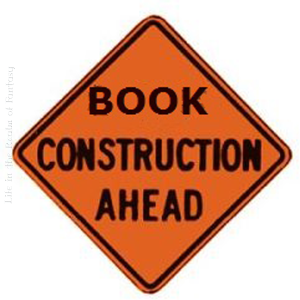 Worldbuilding is the term commonly used for the art of unobtrusively creating the world in which your characters live. Of course, fantasy and science fiction authors clearly need this skill, but all authors must be able to create the world in which their characters live, on the printed page. You, as the author, may know what Seattle looks and smells like, but the reader in London will not.
Worldbuilding is the term commonly used for the art of unobtrusively creating the world in which your characters live. Of course, fantasy and science fiction authors clearly need this skill, but all authors must be able to create the world in which their characters live, on the printed page. You, as the author, may know what Seattle looks and smells like, but the reader in London will not.
Many new authors say, “Well, just make it real in your mind, and it will feel solid in your story.”
That’s not precisely true, because things that are solid in your mind tend to evolve and change with every new day. That is bad for a fantasy world, which is what books are. We are going to make a style sheet, describing the rules of how our world works–because the universe has rules, and if we accidentally break them, the reader will throw our book away. Yes, you are going to write it down and refer back to it as the story progresses.
We begin by thinking about the basic necessities our characters will need to survive. Take a look at the world around us, and see what supports us, what nourishes and shelters us. This is called infrastructure. We need to have this support system completely solid in our minds as we write, so that the reader has the sense of a solid, well-thought out world.
- BUILD YOUR INFRASTRUCTURE: All societies have an economic component to them, whether they are set in space, in Middle Earth, or in Seattle. In any case, there’s nothing worse than a fictional world where there are elaborate social structures that seem completely disassociated from the realities of acquiring food, shelter and clothing. Authors of fiction don’t just write stories—we create whole societies and the economies that support them.
 FOOD and WATER: How do they eat? What do they eat? How does it get delivered? It doesn’t have to be central to the story, but it will come into it at some point because everyone, even vegans, likes to sit down and enjoy a conversation over a good meal, and a society that has no food descends into chaos and war ensues. Do they have certain rituals at meals, a prayer, or do they have formal manners? If they are at home, a small sentence mentioning a napkin or the kind of food will help to set the scene for the reader. If they are in a restaurant or a mess hall, most people will be able to build the picture just from that clue.
FOOD and WATER: How do they eat? What do they eat? How does it get delivered? It doesn’t have to be central to the story, but it will come into it at some point because everyone, even vegans, likes to sit down and enjoy a conversation over a good meal, and a society that has no food descends into chaos and war ensues. Do they have certain rituals at meals, a prayer, or do they have formal manners? If they are at home, a small sentence mentioning a napkin or the kind of food will help to set the scene for the reader. If they are in a restaurant or a mess hall, most people will be able to build the picture just from that clue.
If your story is set on a space station or on a space ship, acquiring food becomes central to the tale, because a certain amount of space inside must be devoted either to storage or to hydroponic gardening.
If you set your tale in 1845 Paris, you must remember that this was the Little Ice Age, and was a time of global famine.
- CLOTHING: People get cold, and need protection. What are they wearing? How do they get it? In some genres, clear descriptions of the garments is needed—most romance novels require some attention to clothing, and if your tale is set in another world or in the past, knowing what they wear becomes very important. You absolutely must understand the constraints certain kinds of clothing will add to your plot.
 If your romance is set in a medieval world, you will want to dress them with some accuracy. Readers are savvy—they will know you haven’t thought it out well if your fully armored knight is suddenly indulging in a moment of passion with fully dressed Lady Gwen. Think about the many layers of what your characters are actually wearing—it can’t be done! For that you must undress your characters, and if they are full armored or wearing Victorian undergarments, it becomes a bit involved. This means they must plan ahead for their romantic trysts and leave the armor at home.
If your romance is set in a medieval world, you will want to dress them with some accuracy. Readers are savvy—they will know you haven’t thought it out well if your fully armored knight is suddenly indulging in a moment of passion with fully dressed Lady Gwen. Think about the many layers of what your characters are actually wearing—it can’t be done! For that you must undress your characters, and if they are full armored or wearing Victorian undergarments, it becomes a bit involved. This means they must plan ahead for their romantic trysts and leave the armor at home.
My book, Huw the Bard is set in a mash-up world—one that has many elements of medieval Britain, but with a few Victorian amenities. I didn’t want clothes to take up a lot of space in the tale, but some mention had to be made.
The trouble Huw had at the outset of the tale was that he was on the run and traveling in disguise. The borrowed shirts of a common working man were made closer-fitting than his traditional bards’ robes, because cloth was expensive and no laborer could afford to waste it on something like big loose sleeves just for fashion. I had to make it so that the straps that ran up his arms and crossed his chest and kept his specially crafted knife sheaths in place didn’t show at all above the rawhide laces at his throat, even when he drew his knives.
It’s only given about three sentences in the actual book, but I had to research what real knife-sheathes are like and how cumbersome they are to wear. In the process I discovered how useless they truly can be. This concept created a certain amount of tension for my plot—he would have to get used to throwing his knives without giving himself away, as he didn’t have the robes to disguise his movements.
When writing fiction, it is important to remember that people are not really that much different nowadays than they ever were. They get cold, so they wear clothes, in many layers. The warmer the weather, the fewer the layers your characters will wear. Inside a warm building, they may be lightly clad. Keep that in mind as you are writing, and convey the idea of their attire with a minimum of words, and your reader will get more enjoyment from the tale.
So, Back to Infrastructure:
- GARBAGE: Who takes away the garbage? Who deals with their bodily wastes? This also doesn’t have to a large part of the story, but in the morning my husband and I are sometimes woken up by the garbage trucks at our house, so it is a part of the environment. And I don’t know about you, but using an outhouse or emptying a chamber pot is the least romantic thing there is, so if your tale is set in the middle ages, be aware that sanitation was minimal and that dealing with it consumed a certain portion of their day.
- TRANSPORTATION: How do they get around? Are they riding horses, or driving cars? If you’ve set your story on a space station, do they get around in some sort of shuttle? It’s a good idea to have some idea of distance, and how far people can travel in a day. Draw a map if your world is a fantasy world, or get a map if it is set in our world. You need to have some idea of where places are in relation to each other, and what the distances between those places are, and what the roads are like because that will have an affect your characters too. If people are flying between London and Toronto, there are certain time constraints that must be adhered to—it’s not an instantaneous thing. The wait at each airport, the time spent in a taxi, the time spent in flight—that is a good chunk of time, so make sure it is considered in your storyline.
-
WORK: What do the majority of your people do to survive? Are they working in a lawyer’s office, or a hospital? Are they farmers? People need to work to survive. In our society today, people identify themselves by their work—”I am an accountant” or “I am an office manager.” We spend 8-10 hours a day at our work, so it is crucial to have your characters’ employment clearly visualized for the reader.
When I decided to set my first book in a medieval setting, I did a certain amount of research on Wikipedia, and found it is actually a good source for quick reference. However, many people whom I admire and respect regularly tell me it’s not the best source for real information about anything. (!!!) SO, ever the intrepid seeker of information, I resorted to investigating in some rather obscure places, but I did find what I needed.
It just took a little time, and a lot of effort. Do the research, and lay the groundwork for your infrastructure. Your readers won’t thank you, but they will be so immersed in the story, they won’t realize the world is a fantasy, and THAT is what you want.
The next installment of this series will explore the world itself–creating the environment and the geography.









All world building should begin with the physical properties of the planet and its solar system, even if those features never are mentioned in the [fantasy] world where the characters have their adventures. Even a primitive people will develop myths about their world, such as “The Red God” being the swollen red giant at the center of their solar system, a star that fills most of the sky above them.
If the civilization advances sufficiently to be aware of such astronomical phenomena, then the story definitely requires scientific knowledge. It’s easy enough to get data on Earth’s properties and then invent a world which is similar or quite different by tweaking those terrestrial properties in appropriate directions–as I did with The Dream Land trilogy featuring planet Ghoupallesz, a world slightly smaller than Earth but with a higher oxygen content in the atmosphere, thereby allowing our Earthling visitors to have a lighter step and greater aerobic capacity.
LikeLike
We are getting there Stephen–it’s a process. That will be Wednesday’s offering!
LikeLike
I cannot tell you how many times I’ve read stories with a really neat location only to wonder ‘why did these people ever settle here, there’s no [food, water, whatever]. Such a wondering destroys immersion. It’s really the little details that get you.
LikeLike
@Lee-I think that is one of failings of some indie-published novels that don’t read well.
LikeLike
Thank you Connie. Your recent posts have been like a lesson plan for a new author’s’ writing course.
LikeLike
Thank you David! I’m putting together materials for several proposed seminars, so my mind is occupied with the craft right now. I’m sort of obsessed–as always.
LikeLike